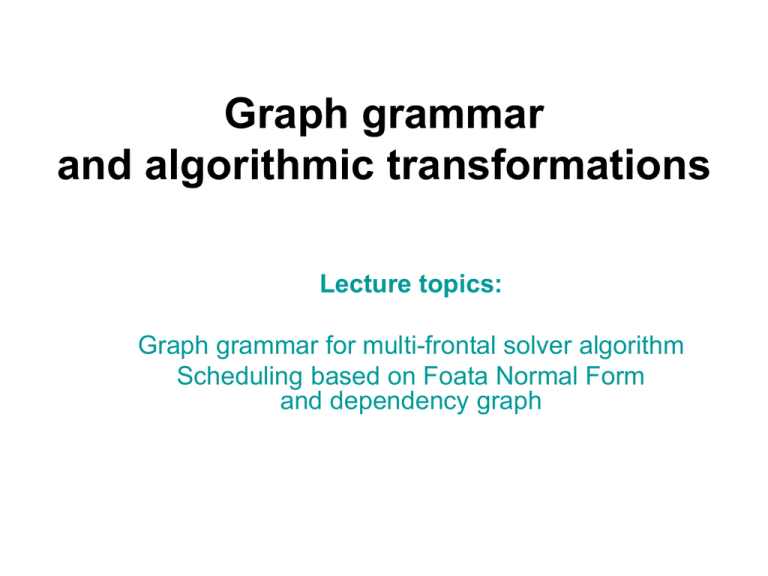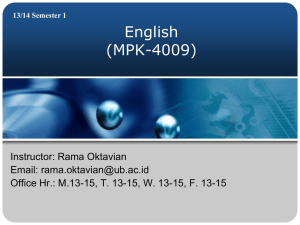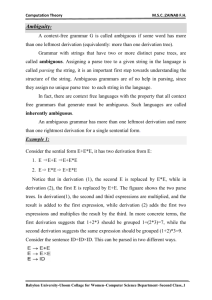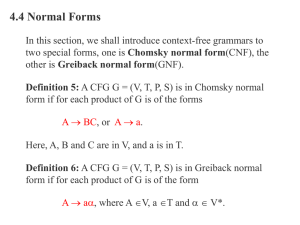Lecture2a
advertisement

Graph grammar
and algorithmic transformations
Lecture topics:
Graph grammar for multi-frontal solver algorithm
Scheduling based on Foata Normal Form
and dependency graph
PROCESS OF THE ELIMINATION
EXPRESSED BY GRAPH GRAMMAR PRODUCTIONS
Graph grammar production construction local matrix for the first sub-interval
Graph grammar production construction local matrix for the i-th sub-interval
Graph grammar production construction local matrix for the last sub-interval
PROCESS OF THE ELIMINATION
EXPRESSED BY GRAPH GRAMMAR PRODUCTIONS
Generation of frontal matrices at leaves of the eliminaton tree expressed as
the execution of graph grammar productions (A1)-(A)4-(AN)
PROCESS OF THE ELIMINATION
EXPRESSED BY GRAPH GRAMMAR PRODUCTIONS
Exemplary merging of two internal contributions
Graph grammar production expressing the merging process
ASSEMBLING AT PARENT LEVEL
Expression of the solver execution by graph grammar productions
(A1)-(A)4-(AN) (generation of frontal matrices at leaves of the elimination trees)
(A2)3 (merging contributions at father nodes)
PROCESS OF THE ELIMINATION
EXPRESSED BY GRAPH GRAMMAR PRODUCTIONS
After merging of the two internal contributions,
the i-th equation is fully assembled, and can be eliminated
Graph grammar production expressing the elimination process
Expression of the solver execution by graph grammar productions
(A1)-(A)4-(AN) (generation of frontal matrices at leaves of the elimination trees)
(A2)3 (merging contributions at father nodes)
(E2)3 (elimination of fully assembled nodes)
PROCESS OF THE ELIMINATION
EXPRESSED BY GRAPH GRAMMAR PRODUCTIONS
Finally, we reach the root of the elimination tree
At the root node, all three equations are fully assembled, and the local system
can be solved now
ELIMINATION OF FULLY ASSEMBLED NODES
Expression of the solver execution by graph grammar productions
(A1)-(A)4-(AN) (generation of frontal matrices at leaves of the elimination trees)
(A2)3 (merging contributions at father nodes)
(E2)3 (elimination of fully assembled nodes)
(A2) – (E2) (merging at parent node followed by elimination)
(Aroot) – (Eroot) (merging at root node followed by full forward elimination)
PROCESS OF THE BACKWARD SUBSTITUTIONS
EXPRESSED BY GRAPH GRAMMAR PRODUCTIONS
At the last stage of the solver execution, we execute partial backward substitutions
TRACE THEORY BASED SCHEDULER
Alphabet:
A={(A1), (A)1 , (A)2 , (A)3 , (A)4 , (AN), (A2)1 , (A2)2 , (A2)3 , (E2)1 , (E2)2 , (E2)3 , (A2)4 ,
(E2)4 , (Aroot) , (Eroot) , (BS)1 , (BS)2 , (BS)3 , (BS)4 }
Dependency relation for the solver algorithm
{(A1),(A)1}D(A2)1
{(A)2,(A)3}D(A2)2
{(A)4,(AN)}D(A2)3
(A2)1D(E2)1
(A2)2D(E2)2
(A2)3D(E2)3
{(E2)1,(E2)2}D(A2)4
(A2)4D(E2)4
{(E2)3(E2)4}D(Aroot)
(Aroot)D(Eroot)
(Eroot)D{(BS)1,(BS)2
(BS)1D{(BS)3,(BS)4}
TRACE THEORY BASED SCHEDULER
Dependency graph
TRACE THEORY BASED SCHEDULER
Dependency graph
TRACE THEORY BASED SCHEDULER
(A1)-(A)1-(A)2-(A)3-(A)4- (AN)-(A2)1-(A2)2- (A2)3-(E2)1-(E2)2-(E2)3- (A2)4- (E2)4(Aroot)-(Eroot)-(BS)1-(BS)2-(BS)3-(BS)4
Foata Normal Form
a a ...a a a ...a ...a a ...a
1 1
1 2
1
l1
2 2
1 2
2
l1
n n
1 2
n
ln
aik A (alphabet)
k i, j 1,..., l k aik Ia kj
k i 1,..., l k j 1,..., l k 1 aik 1 Dakj
Scheduling according to Foata Normal Form:
[(A1)(A)1(A)2(A)3(A)4(AN)][(A2)1(A2)2(A2)3][(E2)1(E2)2(E2)3] [(A2)4][(E2)4]
[(Eroot)][(Aroot)][(Eroot)][(BS)1(BS)2][(BS)3(BS)4]
Thus, the execution of the solver consists of several steps, where independent
tasks are executed in concurrent, interchanged with the synchronization barriers.
NUMERICAL EXPERIMENTS
NVIDIA GeForce 8800 gt with 16 multiprocessors, each having 8 cores
(128 cores total)
1D solver O(logN)
2D solver O(NlogN)
When the number of leaves n is larger than number of processors,
the execution time must be multiplied by n/p










